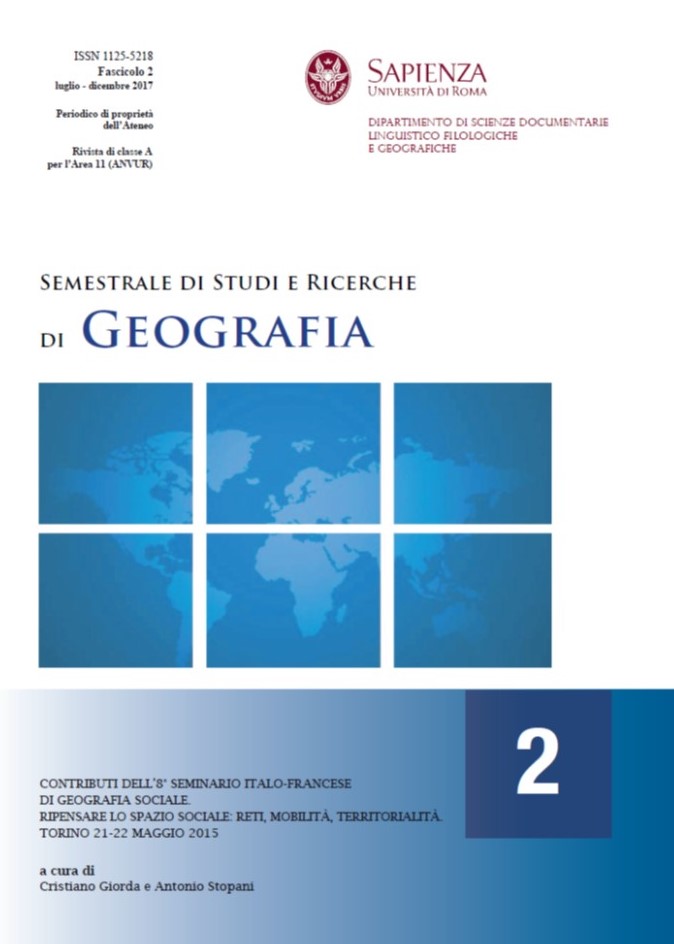“Voci migranti” e paesaggio urbano: per una lettura sonora dei processi migratori nel centro storico di Cagliari
DOI:
https://doi.org/10.13133/1125-5218.15000Abstract
“Migrants’ voices” and urban soundscapes: reading migration
processes in Cagliari’s historical center
This article presents the first results of a research path which aims to explore at the urban scale the relationships existing between the soundscape of a city space and the migratory phenomenon tending to use, amongst the others, the methodology of soundwalking. Focusing the attention on the practices of urban construction by means of sound, the essay concentrates on the modalities by which migrant subjects take part
in the collective and relational process of soundscape construction of the historic centre of Cagliari, re-defining the identity of some places and, furthermore, revealing a certain sense of “sound community”. The investigation identifies four main types of sound spatialities: those of public spaces and daily interactions, those of sacred spaces
and rituality, as well as those of commercial spaces and of the relationships with the “elsewhere”. The “migrant voices” we identify are expression of an otherness that manifest an active practice in claiming an implicit right to citizenship, being in their integration process, expression of new forms of urbanity.
“Voix migrantes” et paysage urbain: pour une lecture sonore des processus migratoires dans le centre historique de Cagliari
Cette contribution présente les premiers résultats d’une recherche qui vise à explorer à l’échelle urbaine le rapport entre paysages sonores et phénomène migratoire, en privilégiant comme outil méthodologique le soundwalking. L’article se concentre sur des pratiques et des processus par lesquels les migrants étrangers participent à la construction collective et relationnelle de paysages sonores du centre historique de Cagliari, en
reconfigurant l’identité de certains lieux et en faisant émerger l’idée de la ville telle une «communauté sonore». L’étude présente brièvement quatre formes de spatialité sonore: celles des espaces publics et de l’interaction du quotidien, du sacré et du rituel, des échanges de commerce, et du rapport à l’ailleurs. Les «voix migrantes» sont ainsi, à la fois, l’expression d’une altérité qui manifeste une pratique active de revendication d’un droit de citoyenneté et, par leur intégration, l’expression d’émergence de nouvelles formes de citadinité.
##submission.downloads##
Fascicolo
Sezione
Licenza
Gli autori che pubblicano su questa rivista accettano le seguenti condizioni:- Gli autori mantengono i diritti sulla loro opera e cedono alla rivista il diritto di prima pubblicazione dell'opera, contemporaneamente licenziata sotto una Licenza Creative Commons - Attribuzione che permette ad altri di condividere l'opera indicando la paternità intellettuale e la prima pubblicazione su questa rivista.
- Gli autori possono aderire ad altri accordi di licenza non esclusiva per la distribuzione della versione dell'opera pubblicata (es. depositarla in un archivio istituzionale o pubblicarla in una monografia), a patto di indicare che la prima pubblicazione è avvenuta su questa rivista.
- Gli autori possono diffondere la loro opera online (es. in repository istituzionali o nel loro sito web) prima e durante il processo di submission, poiché può portare a scambi produttivi e aumentare le citazioni dell'opera pubblicata (Vedi The Effect of Open Access).


